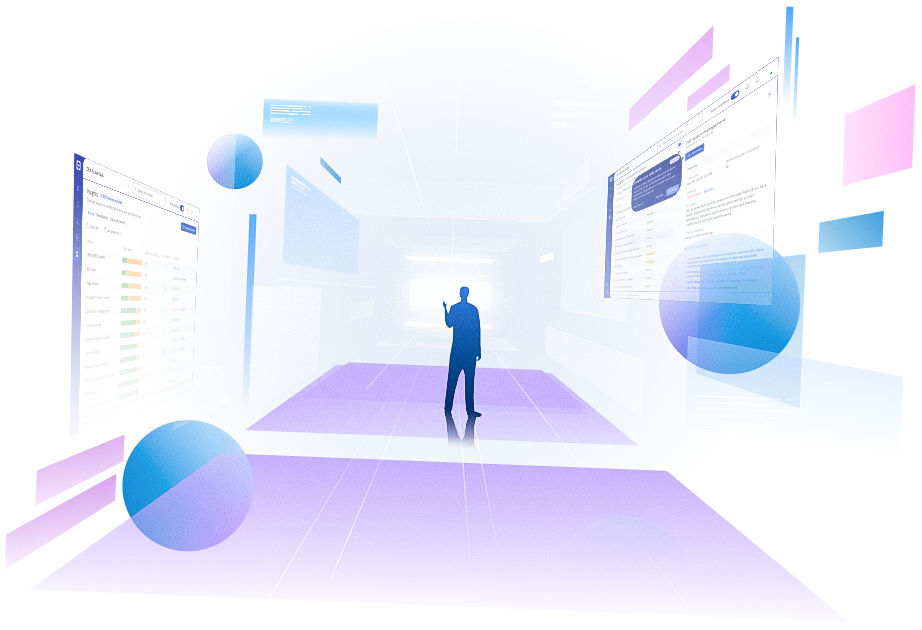Why digital employee experience (DEX) matters more than ever


Let’s start with a clear digital employee experience definition:
The term DEX (digital employee experience) refers to how employees engage with digital tools, platforms, and systems throughout their workday—impacting productivity, satisfaction, and operational efficiency.
Why does it matter? Because every digital interaction shapes the way employees feel about their work. When those experiences are smooth, seamless, and fast, productivity increases. But when systems lag or tools feel clunky, frustration builds—and it shows in increased numbers of support tickets, missed deadlines, and employee turnover. This is the heart of employee experience in digital transformation: You’re not just transforming technology—you’re transforming how people get work done.
Poor digital employee experience doesn't just frustrate employees—it affects your bottom line. When digital systems underperform, they drain time, budget, and morale.
In organizations without mature DEX, common issues like slow logins, frequent app crashes, or complicated interfaces result in:
One of the biggest breakthroughs in modern digital employee experience management is visibility. When IT teams have real-time insight into device health and application behavior, they no longer need to wait for issues to be reported. They can act—instantly. With the right DEX platform in place, problems are detected before they impact productivity. Automated fixes kick in immediately. And intelligent alerts prioritize what matters most.
This shift from reactive firefighting to proactive foresight doesn’t just reduce disruptions—it builds employee trust in workplace technology.
Managing a modern digital workplace experience is no easy feat. Employees switch between desktops, mobile devices, cloud platforms, and collaboration apps—often several times a day.
Common challenges:
For IT teams, these challenges can become overwhelming. For employees, they create digital friction that slows down productivity and fuels frustration. Addressing these issues is essential for delivering a strong digital workforce experience—one that minimizes disruption, enhances satisfaction, and keeps performance on track. Robust endpoint security also plays a key role here. Learn more with TeamViewer endpoint protection.
Let’s take a look at some digital employee experience examples to understand DEX in action:
These examples show that improving DEX doesn’t just reduce frustration—it drives measurable business value.
The most effective digital employee experience strategies follow a structured, proven process. At TeamViewer, we use a four-phase model to move IT teams from reactive support to proactive optimization - delivering long-term results.
The benefits of a strong digital workplace experience go far beyond the IT department. When companies invest in a structured, user-first approach to DEX, they unlock improvements across the board—from happier teams to real business outcomes.
Here are just a few digital employee experience examples that show what’s possible:
Implementing a successful digital employee experience strategy doesn’t require a full tech overhaul—but it does require a mindset shift. Here’s how to start:
1. Map your current digital workplace experience
Conduct internal interviews and feedback loops to understand which tools frustrate employees—and which support them. Prioritize user sentiment just as much as system performance.
2. Identify key friction points
Where are employees losing time? Where do support tickets spike? Map these digital "pain points" across the employee journey—from onboarding to offboarding.
3. Select a scalable DEX platform
Choose a platform that allows for real-time monitoring, proactive problem-solving, and integration with your existing IT ecosystem (e.g., Microsoft Intune, ServiceNow, etc.).
4. Align IT and HR
DEX is not just an IT initiative. Bring HR into the conversation to connect technical performance with engagement, well-being, and retention goals.
You can’t improve what you don’t measure. That’s why DEX success is driven by data. Below are key metrics to track:
With TeamViewer’s integrated DEX platform, these metrics are visible in real time—allowing IT to act proactively, not reactively.
Strong digital employee experience is almost invisible—and that is the point. When tools are responsive, systems are stable, and employees do not hit roadblocks, work just flows. The result is a workplace where people stay focused, IT is not constantly firefighting, and business outcomes improve. Good DEX does not shout. It just works.
And those that don’t? Risk losing it all to digital friction.
TeamViewer DEX powers proactive IT problem-solving across all endpoints and environments, using real-time insights and intelligent automation.
Digital work experience refers to the day-to-day interaction with digital tools and platforms. A good experience means fast, reliable tech that enables productivity and collaboration.
A DEX strategy is a plan to optimize digital touchpoints in the workplace. It combines real-time monitoring, automation, and user feedback to improve tech performance and employee satisfaction.
DEX is measured using metrics like device uptime, issue resolution time, ticket volume, and employee feedback. These help track performance and identify areas for improvement.